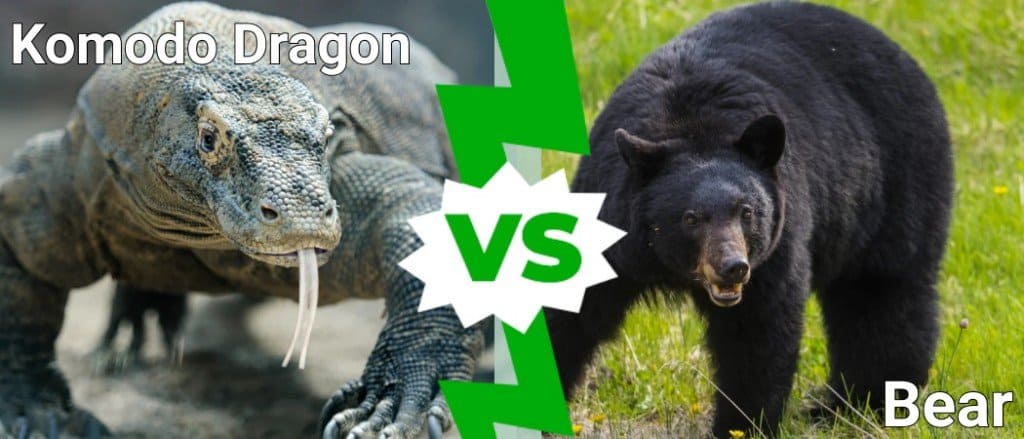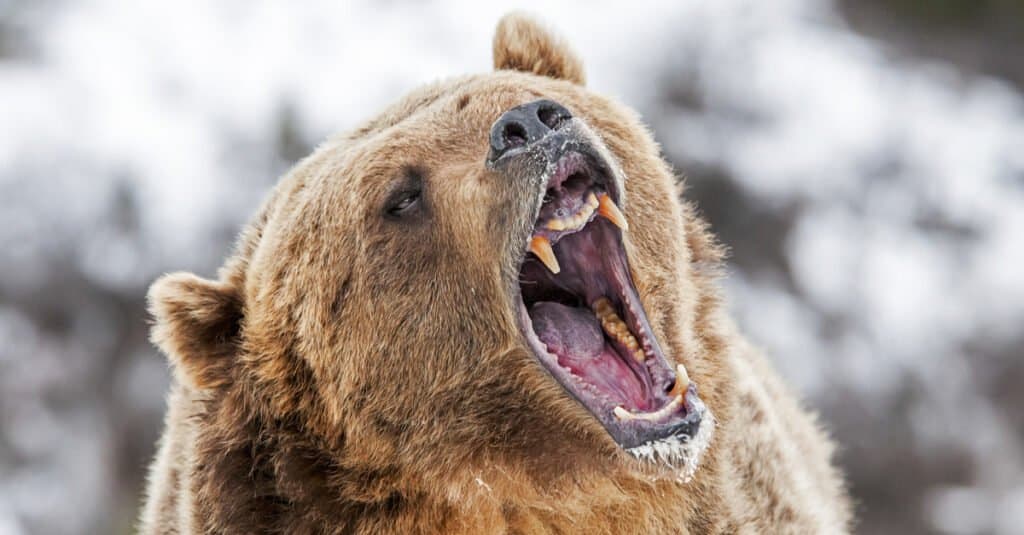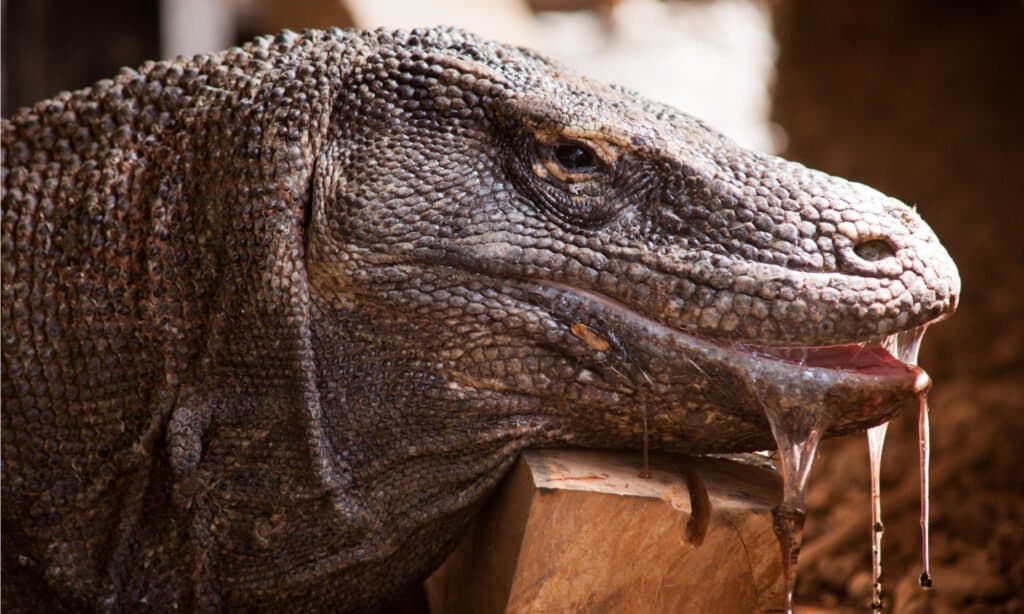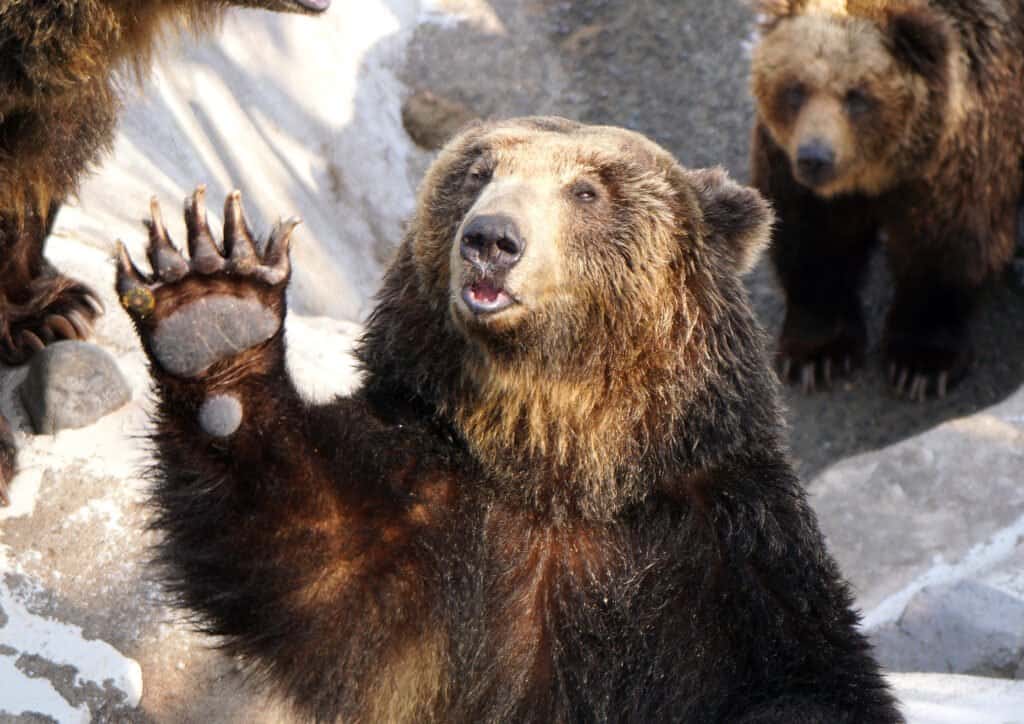Many fierce predators exist around the world that strike fear into people. Bears are well-known as animals that people need to avoid if they value their lives. Still, lesser-known creatures, like Komodo dragons are just as scary to people in their range. Both creatures are formidable, but they live far apart. However, if a bear decided to take a long swim to Indonesia, then some species of bear could encounter a Komodo dragon. We’re going to take a look at a Komodo dragon vs bear fight and show you which of these animals is most likely to win a fight.
Comparing a Komodo Dragon and a Bear

| Komodo Dragon | Bear | |
| Size | Weight: 150lbs – 300lbs Height: 1.5ft-2ft Length: 6ft-10ft | Weight: 60lbs – 990lbs Height: 2ft – 5ft at shoulder, up to 9ft standing Length: 4.5ft – 9.5ft |
| Speed and Movement Type | 11 mph top speed | 25-35 mph |
| Senses | – Good eyesight – Use their tongues and Jacobson’s organ to smell and taste their environment and find prey from miles away – Poor hearing | – Some bears can smell from several miles away – Hearing twice as good as humans – Good vision and some bears can see better at dusk. |
| Defenses | – Hard skin with strong scales that are reinforced with bony deposits called osteoderms – Speed | – Large size – Speed to run away – Fierce threat displays – Ability to traverse land and water -Climbing ability |
| Offensive Capabilities | – Possibly venomous – Sharp claws hold prey in place – Sharp teeth lead to exsanguination in victims | – Powerful, bone-breaking bites – Sharp claws that can tear open prey – Uses weight to pin down enemies |
| Predatory Behavior | – Ambush predators – Tries to knock down and bite vital areas on prey, typically the neck. | – Ambush predator in some cases, waiting for prey – Opportunistic predator that pursues and kills prey in other cases – Typically secures a kill with a single, powerful bite to the throat. |
What Are Key Differences Between a Komodo Dragon and a Bear?

Bears are large mammals that can reach 9ft tall and run at 35 mph
©Scott E Read/Shutterstock.com
The biggest differences between a Komodo dragon and a bear are size and morphology. Bears can grow much larger than Komodo dragons, and they are quadrupedal mammals with fur, while Komodo dragons are large reptiles with reinforced scales throughout the body. These animals have several other differences, too.
Looking at the ways that these creatures are unique provides insight into the advantages they might have over the other. With that in mind, we must look at several dimensions of this fight to figure out the winner.
What Are the Key Factors in a Fight Between a Komodo Dragon and a Bear?

The battle between Komodo dragons and bears boils down to their fighting abilities and physical advantages
©Luca Vaime/Shutterstock.com
Bears and Komodo dragons are both apex predators in their territories since nothing hunts them. In order to determine which animal wins this battle, we have to evaluate them according to several criteria.
We’ll examine their biology along with how they use their bodies in a fight. We’ll assign some advantages to each animal for certain qualities and use that data to figure out which animal is the winner!
Komodo Dragon vs Bear: Size
Komodo dragons are smaller than bears. Based on their species, some of the larger bears can reach up to 900lbs or more, stand 9ft tall when on two feet, and grow over 9ft long.
Granted, Komodo dragons can grow up to 10ft long, but much of that length is their tail. They stand about 2ft off the ground and can weigh 300lbs. All in all, their size pales in comparison to a bear.
Bears have the size advantage.
Komodo Dragon vs Bear: Speed and Movement
Bears are faster than Komodo dragons. Bears can reach blazing speeds of 35 mph, allowing them to hunt down basically any creature in their range. Komodo dragons can only move at about 11 mph, so they would have no way to escape the fight once they are engaged.
Bears have the advantage in terms of speed.
Komodo Dragon vs Bear: Senses
Komodo dragons and bears are both very powerful hunters, so they have acute senses. Bears have a powerful sense of smell that enables them to detect scents from miles away. Their hearing is about twice as good as humans, and their vision allows them to see well during the day and good around dusk.
Komodo dragons, like other reptiles, have Jacobson’s organs, and that allows them to taste and smell the chemicals in the air to figure out the location of food and prey. They also have good eyesight but poor hearing.
Bears have better senses than Komodo Dragons overall.
Komodo Dragon vs Bear: Physical Defenses
Bears rely on their speed and fierce threat displays to scare off their enemies. They also have a large body covered in thick fur that can help them ward off some attacks. Helping matters is the fact that they can climb trees, run on the land, and swim very well.
Komodo dragons don’t escape from fights— they either win or perish. They have scales with bony deposits called osteoderms running throughout them. That can stop some damage but not all.
Bears have better and more diverse defenses compared to Komodo dragons.
Komodo Dragon vs Bear: Combat Skills
Komodo dragons are ambush predators that look for an opportune moment to attack their prey. They rush to them, try to knock them down, and then attack their vital areas. They have weak saliva-borne venom, serrated teeth, and powerful, sharp claws to deal damage to their foes. Komodo dragons leave a bloody mess in their wake.
Bears can be ambush predators or opportunistic, endurance predators. When they attack creatures, they will deliver bone-breaking bites, smacks with their powerful paws that end in deadly sharp claws. They can also stand up to their full height and then bring their body down on their enemies. Their final blow is usually a single bite to the throat.
Who Would Win in a Fight Between a Komodo Dragon and a Bear?

A bear would dominate a Komodo dragon in a fight.
©VANESSAL/Shutterstock.com
A bear would beat a Komodo dragon in a fight, but it might get bloody. The problem that Komodo dragons face is that they are very short compared to a bear. For example, if a Komodo dragon approached a grizzly bear, the bear would stand on its legs to appear bigger and scare it away.
From that stance, the Komodo dragon would not be able to inflict fatal damage unless it manages to climb up the bear! The more likely outcome would see the bear identifying the Komodo dragon as a threat, and then using all its weight and power to kill it.
The bear would maul the Komodo dragon with incredible paw swipes, claw strikes, and bone-breaking bites. The Komodo dragon could inflict some damage with its sharp teeth, but it’s not going to deal a fatal strike a bear before dying in the process.
What Animal Could Defeat a Bear?
There is a reason bears are at the top of the food chain. Their size, strength, and ferocity leave them unmatched. Usually, animals that prey on bears, such as wolves or moose, will only feed on cubs. What animal could take on a full grown bear and win a fight? The rhinoceros! While bears are daunting due to their massive sizes and power, rhinos have them beat. Rhinos can weight up to 7,000 pounds, grow 6 feet tall, and stretch 11 to 15 feet long. They also have defensives bears don’t have, such as extremely thick, armor-like skin and horns. A bear’s bite or claws may not even penetrate their 2-inch thick protective layer. When it comes to speed, bears can attack at 35 miles per hour and rhinos at 34. For an animal so much bigger than the bear, it’s amazing how fast it can move.
Once a fight between the two ensues, the bear would most likely attack by jumping on the rhino and biting and clawing at a vital area such as the neck. The armored skin would prevent death. Eventually, the rhino would impale the bear or trample it to death.
The photo featured at the top of this post is © Sergey Uryadnikov/Shutterstock.com
Thank you for reading! Have some feedback for us? Contact the AZ Animals editorial team.






